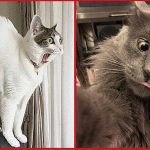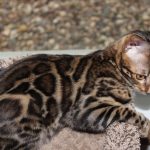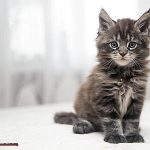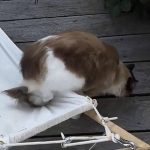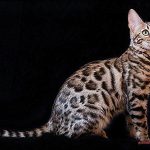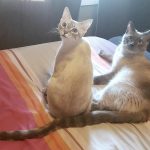Are you eagerly anticipating the day when your Ragdoll kitten reaches their full fluff potential? The fluffy coat of a Ragdoll is undoubtedly one of their most charming features, but when exactly can you expect your furry friend to become fully fluffed?
Ragdolls are renowned for their semi-long, plush coats that come in an array of colors and patterns. While some kittens are born with a fluffy coat, others may take a little longer to develop their signature fluff. So, what’s the typical age for your Ragdoll to achieve peak fluffiness?
There’s no definitive answer to this question since every Ragdoll cat is unique and develops at its own pace. However, most Ragdoll cats will begin to grow their full coats between 2-3 years of age. During this time, their coat may also become denser and softer.
While it might seem like a long wait for your Ragdoll to reach full fluffiness, the end result is well worth it. So sit back, enjoy those adorable kitten snuggles, and look forward to the day when your Ragdoll blossoms into its fully fluffy self.
What Is a Ragdoll Cat?
From their soft, fluffy coat to their gentle disposition, there’s no denying that Ragdolls make excellent pets.
These felines were first bred in the 1960s by Ann Baker in Riverside, California. Baker selectively bred cats with specific traits, including a relaxed disposition and the ability to go limp when picked up. This is where the name “Ragdoll” comes from – they truly do resemble a floppy ragdoll when held.
Apart from their charming personality, Ragdoll cats are known for their distinctive pointed coloration. They have darker fur on their ears, feet, tail, and face, which contrasts beautifully with their lighter body fur. Their fur is medium to long in length and has a silky texture that is less prone to matting or tangling than other long-haired breeds. Additionally, their coat comes in various colors and patterns, such as seal point, blue point, chocolate point, lilac point, and red point.
Ragdolls are typically larger than most domestic cats. Males can weigh between 15-20 pounds and females between 10-15 pounds. They’re affectionate and love to cuddle with their humans, making them great companions for families and individuals alike.
If you’re considering adopting a Ragdoll cat, it’s crucial to remember that they require regular grooming to maintain their fluffy appearance. Brushing their fur regularly will help prevent matting and tangling of their coat. Additionally, providing them with a healthy diet will contribute to the overall health and appearance of their coat.
What Factors Affect the Fluffiness of a Ragdoll Cat?
Look no further than the fluffy Ragdoll cat. But what factors affect their fluffiness? Let’s explore the genetics, age, diet, grooming, and environment that all play a role.
Genetics is the first factor in determining the fluffiness of your Ragdoll cat. Some cats are simply born with thicker and longer fur than others. Breeders meticulously select cats with desirable traits like fluffy fur to produce similarly fluffy offspring. A Ragdoll kitten from a breeder is more likely to have a fluffy coat than a rescue cat.
Age is another factor that affects the fluffiness of a Ragdoll cat. Kittens have softer and fluffier fur than adult cats because their hair has not fully developed yet. However, with proper care, you can maintain your cat’s fluffiness even as it ages.
A healthy diet also plays a crucial role in promoting healthy hair growth and maintaining your cat’s soft and fluffy coat. A diet rich in essential nutrients like protein, vitamins, and minerals will keep the coat shiny and healthy. Avoid foods lacking these essential nutrients as they can cause dull and brittle fur.

Grooming is another critical factor in keeping your cat’s fur fluffy. Regular grooming sessions can help distribute natural oils throughout the coat, keeping it shiny and healthy. Brushing your cat’s fur daily can also help remove loose hair and prevent matting, which can be uncomfortable for your cat and lead to skin irritation or infections.
Finally, the environment in which your Ragdoll lives can impact the fluffiness of its coat. Exposure to sunlight and fresh air can promote healthy hair growth, while excessive heat, humidity, or exposure to harsh chemicals can damage it.
When Will My Ragdoll Become Fluffy?
While it may take some time and care, with a little patience, your furry friend can develop the luscious coat that makes them so irresistible.
First and foremost, age plays a crucial role in determining when your Ragdoll will become fluffy. Ragdoll kittens are undoubtedly adorable, but their fur is short and thin. As your Ragdoll grows older, their fur will start to thicken and become more plush. Generally, Ragdolls reach their full fluff potential around two years of age, although some may take longer.
Genetics are another critical factor in a Ragdoll’s fluffiness. If your Ragdoll’s parents have thick and luxurious coats, there’s a good chance your kitty will inherit the same traits. However, if the genes aren’t in their favor, don’t fret – proper care can still make a big difference.
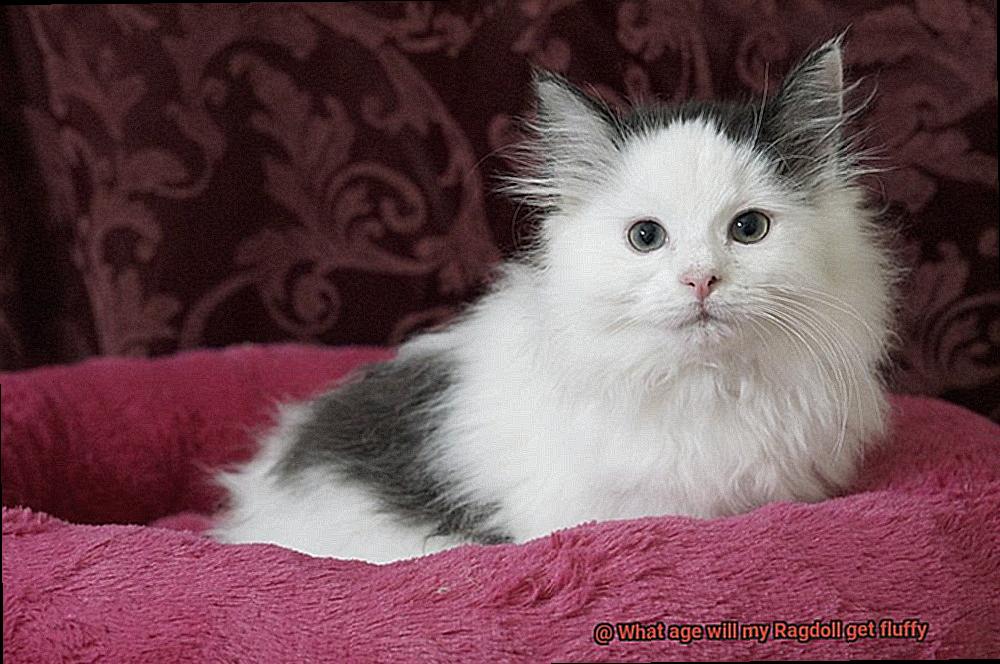
Nutrition also plays a significant role in developing a fluffy coat for your Ragdoll. A well-balanced diet that is rich in essential nutrients and vitamins promotes healthy hair growth and gives your cat’s coat a healthy shine. Experts recommend feeding your Ragdoll high-quality food that is rich in protein and omega-3 fatty acids.

Lastly, grooming is key to maintaining a fluffy and healthy coat for your Ragdoll. Regular brushing helps remove mats and tangles from the fur while promoting blood circulation and distributing natural oils evenly throughout the coat. This results in a shiny, soft-to-the-touch coat that you’ll love snuggling up with.
Genes and Fluffiness
Let’s start with the burning question: how do genes, diet, and grooming affect a Ragdoll’s fluffiness? Genetics is the primary factor in determining a Ragdoll’s fluffiness. The long hair gene is responsible for their signature fluffy coat, which is inherited from both parents. However, not all kittens are born with a full coat of fur, and their fluffiness increases as they mature. Each cat’s unique genetics also influence their level of fluffiness.
So when can we expect our Ragdoll to reach their maximum fluff potential? Most cats will develop their full coats at around 2-3 years of age. However, some may take longer, while others may reach their maximum fluffiness earlier than expected. It’s important to keep in mind that every cat develops at their own pace.
Now let’s talk about how diet and grooming can impact your kitty’s coat. A balanced diet rich in nutrients can promote healthy hair growth, leading to a fuller and fluffier coat. Make sure your furry friend is getting the proper nutrients they need from their food to support healthy hair growth.
Grooming is crucial for maintaining a fluffy coat. Regular brushing helps prevent matting and removes loose fur, making the coat appear fuller. Plus, it’s an excellent bonding opportunity for you and your fluffy companion.
Grooming and Fluffiness
Look no further because we have all the secrets to keeping your feline friend’s coat looking fabulous.
Firstly, let’s talk about the importance of grooming. While Ragdolls are known for their low-maintenance coats, regular grooming is essential in preventing mats, tangles, and even health issues. So, grab your brush and get ready to bond with your fluffy friend. Brushing their coat at least once a week will keep their fur looking silky and smooth, which is essential for maintaining their fluffiness.
Next up is nutrition and hydration. Just like with humans, a balanced diet and proper hydration are necessary for healthy hair growth. Ensure that your Ragdoll is getting a well-balanced diet that includes all the necessary nutrients they need to maintain a healthy coat. And don’t forget the importance of water. Make sure your kitty has access to clean water at all times to keep them hydrated and their coat shiny.
Now, let’s dive into when your Ragdoll will become fluffy. It’s important to note that the breed has a slow maturation process, typically reaching full physical maturity between 3-4 years old. However, don’t worry if your kitten doesn’t have a full coat just yet. They are born with a soft layer of fur that gives them a bit of fluffiness from the start, and their fur will continue to become longer and fuller as they grow.
But what exactly makes Ragdolls so fluffy? Their signature fluffiness is a result of their long, soft fur. This luxurious coat requires regular grooming and upkeep to maintain its softness. Neglecting grooming can lead to mats, tangles, and even health issues for your furry friend.
To maintain this fluffiness, it’s crucial to establish a grooming routine early on in your Ragdoll’s life. This includes brushing their coat at least once a week to prevent mats and tangles from forming. It’s also important to ensure that your Ragdoll is getting proper nutrition and hydration to keep their coat healthy and shiny.
Diet and Fluffiness
Let’s explore how nutrition and hydration can contribute to a healthy and fluffy coat.
Firstly, a well-balanced and nutritious diet is essential for healthy hair growth. A diet rich in protein and healthy fats can promote a fuller and fluffier coat. Look for high-quality cat food that contains essential nutrients like vitamins, minerals, and amino acids.
But that’s not all – water is also crucial for maintaining healthy skin and hair, which directly affects the fluffiness of your cat’s coat. Make sure your Ragdoll has access to clean drinking water at all times to promote overall coat health and fluffiness.
Supplements such as omega-3 fatty acids can also contribute to your cat’s fluffiness by promoting healthy hair growth. These supplements can be found in certain types of cat food or as separate supplements.
However, while proper nutrition is crucial for a fluffy coat, overfeeding your Ragdoll can lead to obesity, decreased mobility, and fur matting. So, maintaining a healthy weight through proper nutrition and exercise is crucial for promoting a fluffy and healthy coat.
In summary, to achieve the fluffiest coat possible for your Ragdoll cat, ensure they have a well-balanced and nutritious diet high in protein and healthy fats, access to clean drinking water, and consider incorporating supplements such as omega-3 fatty acids. Remember, maintaining a healthy weight through proper nutrition and exercise is also critical for your cat’s overall health and appearance.
Other Factors That Impact Fluffiness
While genetics do play a significant role in determining coat fluffiness, there are other factors to consider. Let’s explore these factors and how to keep your cat’s coat looking luscious and fluffy.
Firstly, diet is vital. A well-balanced diet rich in protein and essential fatty acids can contribute to a thick and shiny coat. These nutrients promote healthy hair growth and skin, leading to fluffier coats. However, overfeeding can lead to obesity and fur matting, so maintaining a healthy weight through proper nutrition and exercise is crucial.
Regular grooming is also essential. Brushing and grooming help remove loose fur and prevent matting. This stimulates natural oil production, giving their coat a shinier and healthier appearance. Plus, it’s an excellent bonding activity for you and your furry friend.
The environment your cat lives in can also impact their fluffiness. Dry or dusty environments can cause fur to become dry and brittle, leading to shedding and less fluffiness. It’s important to provide a clean and comfortable living space for your Ragdoll to maintain their coat’s health. Regular baths can also help remove dirt and debris that can weigh down their fur.
Lastly, stress can impact the fluffiness of their coat. Cats under stress may experience hair loss or thinning of their coat. Reducing stress levels by providing them with a calm and relaxing environment, including plenty of toys, scratching posts, and cozy spaces to retreat to, is essential.
Tips for Maintaining Your Ragdoll’s Fluffy Appearance
Ragdoll cats are known for their long, silky, and fluffy coats that require regular maintenance to keep them looking their best. Here are five essential tips to help you maintain your Ragdoll’s signature fluffy appearance.
Tip 1: Regular Brushing
Regular brushing is crucial to prevent matting and keep your Ragdoll’s fur fluffy. Use a high-quality brush, such as a slicker brush or a comb, to remove any knots or tangles gently. Start at the top of the head and work your way down to the tail, distributing natural oils throughout the coat.
Tip 2: Proper Bathing
Bathing your Ragdoll once every few months with a mild shampoo is recommended to keep their fur clean and shiny. However, avoid over-bathing as it can strip the natural oils from their coat, leaving it dry and brittle. Be sure to rinse thoroughly to avoid any residue that can make the coat look dull.
Tip 3: Proper Nutrition
Proper nutrition is essential for maintaining your Ragdoll’s fluffy appearance. A balanced diet rich in essential fatty acids can help promote healthy skin and a shiny coat. Talk to your veterinarian about the best food options for your cat and consider adding supplements like fish oil or omega-3 fatty acids to their diet.
Tip 4: Regular Grooming
Regular grooming sessions with a professional groomer can be beneficial for your Ragdoll’s coat. They can provide services such as trimming around the face and paws, which can help prevent matting and tangles. Groomers can also identify any potential skin or coat issues early on.
Tip 5: Invest in a High-Quality Brush
Investing in a high-quality brush specifically designed for long-haired cats is essential for maintaining your Ragdoll’s fluffy appearance. Look for a slicker brush or a comb with long teeth that can reach deep into the undercoat without causing any discomfort or irritation. Regular brushing helps distribute natural oils and remove any tangles.
PfhK6LeXMV8″ >
Conclusion
In conclusion, the fluffiness of a Ragdoll cat is an irresistible trait that captures the hearts of many pet owners. Although there is no exact timeline for when a Ragdoll will achieve full fluffiness, most cats reach their peak fluffiness between 2-3 years old. However, various factors such as genetics, diet, grooming habits, and living environment can all influence the level of fluffiness.
To maintain your Ragdoll’s soft and fluffy coat, proper nutrition is crucial for healthy hair growth. Regular grooming sessions can also help distribute natural oils throughout the coat while preventing matting and tangling. Additionally, providing your feline friend with a clean and comfortable living space can promote healthy hair growth.
Although it may seem like a long wait for your Ragdoll to reach full fluffiness, rest assured that it’s worth it. By following these tips for maintaining your Ragdoll’s fluffy appearance – regular brushing, proper bathing techniques, nutritious meals, professional grooming services, and investing in high-quality brushes – you can ensure that your beloved pet looks their best at all times.

